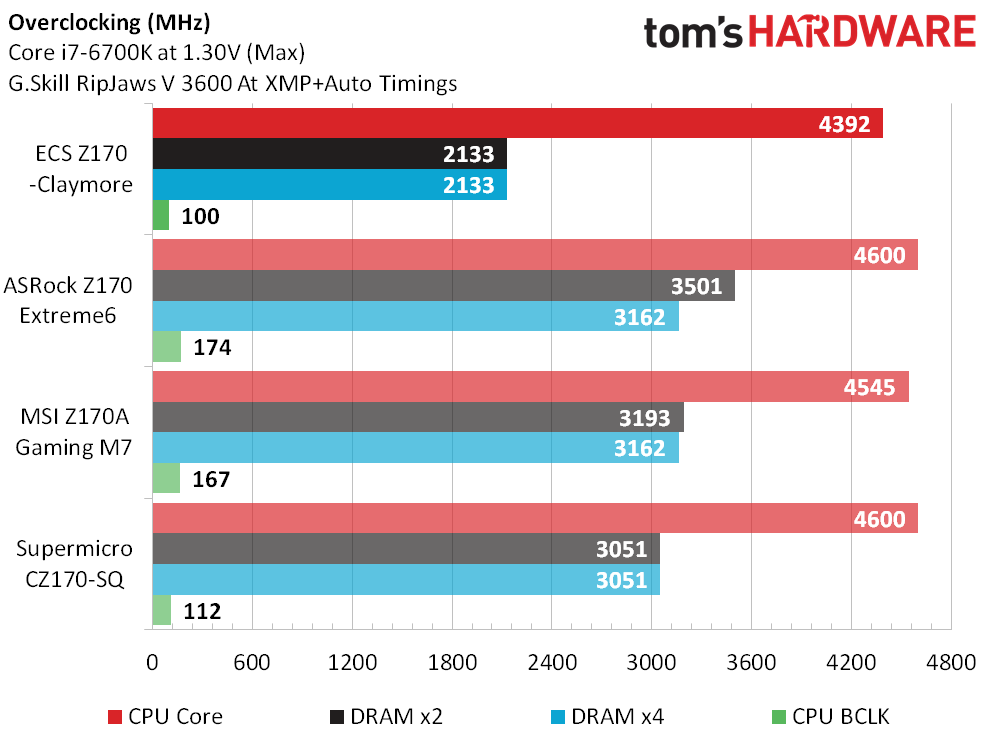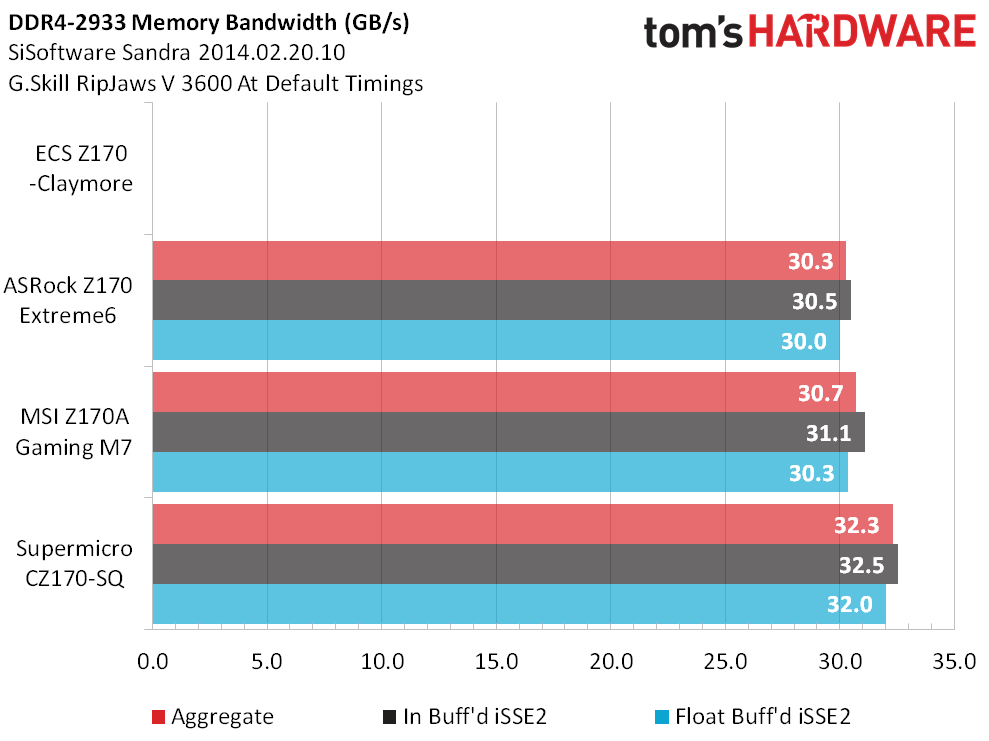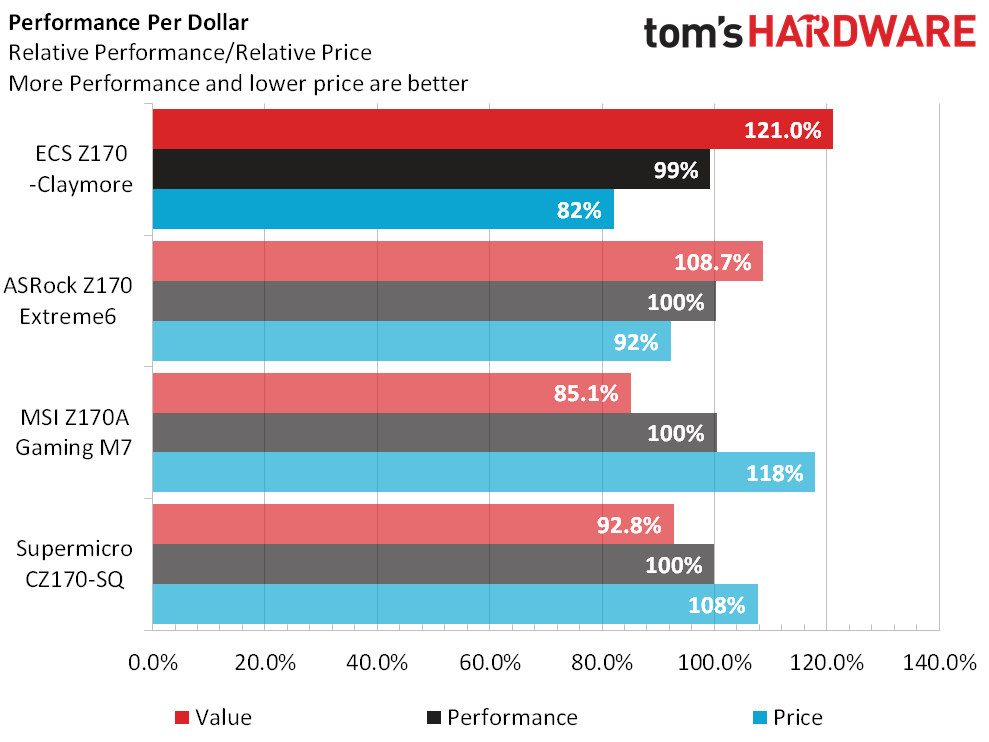ECS Z170-Claymore Motherboard Review
The Claymore leaves little doubt about ECS’ intent to stay in the enthusiast space, but how does it stack up to competitors?
Why you can trust Tom's Hardware
Overclocking, Value And Conclusion
Just when some users thought ECS was going to pull out of the enthusiast motherboard market, the firm drops a Claymore in the mix. Those fortunately don’t explode when dropped, but could potentially blow away the competition in value.
Unfortunately, the Z170-Claymore’s power protection scheme prevented it from reaching the expected 4.6 GHz, as the voltage required to keep the CPU stable forced the frequency to go down. The chart might say 1.30V (MAX), but the board throttled the CPU when asked to provide more than 1.26V to its core (at high clocks and full load).
A firmware issue prevented memory overclocking, but that appears specific to “unfamiliar” modules. We anticipate a patch for that.
Without the ability to manually configure our memory using this version of Z170-Claymore firmware, the overclocked bandwidth chart shows a hole. Similar firmware issues kept Supermicro’s CZ170-SQ operating at the memory’s default CAS 15 in this test, and fans looking for a horn to blow should probably consider one of the two properly functioning samples as their instrument.
ECS might not have gotten its firmware right yet, but fairly solid hardware puts its Z170-Claymore in a value race against the second board in the above chart, ASRock’s Z170 Extreme6. The above chart doesn’t, however, show how much more a product with more features is actually worth.
The Z170-Claymore is certainly cheaper than the Z170 Extreme6, but is the price low enough to offset its lesser feature set? The Extreme6 does have a four-lane M.2 slot for example, but the Z170-Claymore offsets that advantage by having a second four-lane PCIe slot. And the Extreme6 has a couple extra SATA ports, but those are shared with M.2 where the Claymore’s SATA to M.2 interface is dedicated to its purpose. Both motherboards have exactly one added ASM1061 SATA controller and one added ASM1142 PCIe controller onboard.
The Extreme6 has a slightly more-popular network controller (Intel vs Realtek), an onboard optical S/PDIF output, and a DTS Connect to make that output truly useful. It also includes a dual-port USB 3.1 drive bay adapter with its own ASM1142 controller, and the latter part is probably worth the $20 price difference to those who need it. In the best case for ECS, this is probably a value tie. Buyers who can’t afford or justify the extra expense will probably want to consider the Z170-Claymore anyway.
Get Tom's Hardware's best news and in-depth reviews, straight to your inbox.
MORE: Best MotherboardsMORE:
How To Choose A MotherboardMORE: All Motherboard Content
MORE: Motherboards in the Forums
Thomas Soderstrom is a Senior Staff Editor at Tom's Hardware, covering Cases, Cooling, Memory and Motherboards. Follow him on Twitter.
Follow Tom's Hardware on Twitter, Facebook and Google+.
-
utroz Seriously where is the Display Port. HDMI is for TV"s not real monitors. I can use a passive adapter from DP to HDMI if I want to use a crappy TV as a monitor..Reply -
SinxarKnights Sorry ECS. I have used your boards in the past and they all died a horrible death for no apparent reason.Reply
Since I first spotted these MBs on Newegg, calling them LEET seems like they are spitting in my face. I actually thought it was a scam until I later learned they are ECS boards.
I don't know about others but when I look for a quality motherboard it better not have l337 in the title, it just reeks of some garbage you would try to market to very young children... or maybe that is the goal? -
bignastyid Atleast they named it right. Who is going to be surprised when something named Claymore blows up.Reply -
Crashman Reply
Every problem I've had with ECS has been firmware-related. I really don't expect it to "blow up".16572439 said:Atleast they named it right. Who is going to be surprised when something named Claymore blows up.
-
bignastyid Reply16572532 said:
Every problem I've had with ECS has been firmware-related. I really don't expect it to "blow up".16572439 said:Atleast they named it right. Who is going to be surprised when something named Claymore blows up.
It was more a figurative term, sounded better than die young. Which is what I have seen them do most often(a couple did have exploded capacitors), but this was years ago don't see them as often any more(thank god). Now of they made power supplies like their motherboards they probably would literally blow up. -
Crashman Reply
ECS has been doing OK on the hardware side since its first gaming brand launch 2005, but every time they get close to having a decent firmware they change it up and start over again.16572559 said:16572532 said:
Every problem I've had with ECS has been firmware-related. I really don't expect it to "blow up".16572439 said:Atleast they named it right. Who is going to be surprised when something named Claymore blows up.
It was more a figurative term, sounded better than die young. Which is what I have seen them do most often(a couple did have exploded capacitors), but this was years ago don't see them as often any more(thank god). Now of they made power supplies like their motherboards they probably would literally blow up.
-
Mac266 ReplyAtleast they named it right. Who is going to be surprised when something named Claymore blows up.
A Claymore is a large two-handed sword. -
Crashman Reply
OK, now using it that way would probably break it.16580242 said:Atleast they named it right. Who is going to be surprised when something named Claymore blows up.
A Claymore is a large two-handed sword.



